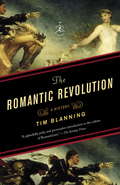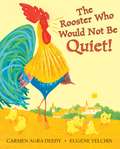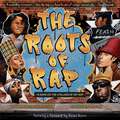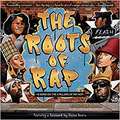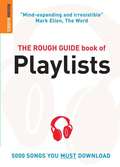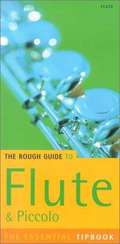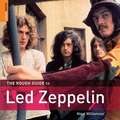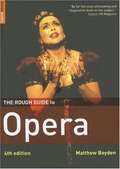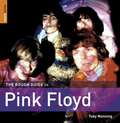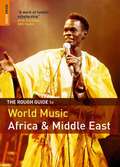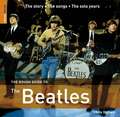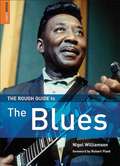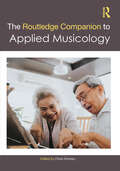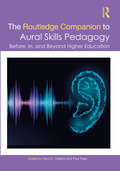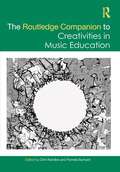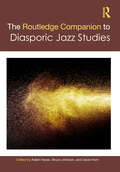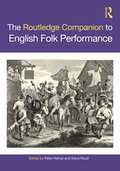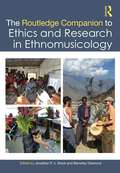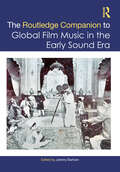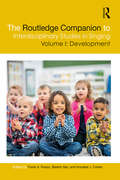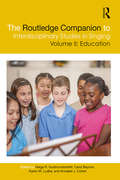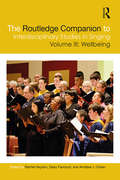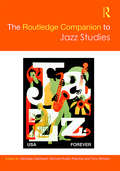- Table View
- List View
The Romantic Overture and Musical Form from Rossini to Wagner
by Moortele Steven VandeIn this book Steven Vande Moortele offers a comprehensive account of operatic and concert overtures in continental Europe between 1815 and 1850. Discussing a broad range of works by German, French, and Italian composers, it is at once an investigation of the Romantic overture within the context of mid-nineteenth century musical culture and an analytical study that focuses on aspects of large-scale formal organization in the overture genre. While the book draws extensively upon the recent achievements of the 'new Formenlehre', it does not use the overture merely as a vehicle for a theory of romantic form, but rather takes an analytical approach that engages with individual works in their generic context.
The Romantic Revolution
by Tim BlanningFrom the preeminent historian of Europe in the eighteenth and nineteenth centuries comes a superb, concise account of a cultural upheaval that still shapes sensibilities today. Long overshadowed by the contemporaneous American, French, and Industrial revolutions, the Romantic Revolution finally receives its due in Tim Blanning's bold and brilliant work.A rebellion against the rationality of the Enlightenment, a rejection of "the Academy" in favor of public opinion, Romanticism was a profound shift in expression that altered the arts and ushered in modernity, even as it championed a return to the intuitive and the primitive. Blanning describes its beginnings in Rousseau's novel La Nouvelle Héloïse, the biggest bestseller of the eighteenth century, a work that placed the creator--and not the created--at the center of aesthetic activity and led to the virtual worship of creative geniuses by the general public. Blanning reveals the glamorizing of artistic madness and suicide in Goethe's novel The Sufferings of Young Werther and the ballet Giselle; the role of sex as a psychological force in Friedrich Schlegel's novel Lucinde; the importance of mind-altering drugs to the fictional protagonist of Confessions of an English Opium Eater and to the composer Hector Berlioz in his Symphonie fantastique; and the use of naïve, dreamlike imagery in Goya's paintings of monsters, devils, and witches.Whether it was the new notion of "sex appeal" in the fames of Paganini, Liszt, and Byron, or the celebration of accessible storytelling in the novels of Walter Scott (the most popular writer of the day), The Romantic Revolution unearths the origins of ideas now commonplace in our culture. It is the best introduction to an essential time whose influence would far outlast the mechanistic "age of the railway" that, in the mid-nineteenth century, replaced it.From the Hardcover edition.
The Rooster Who Would Not Be Quiet!
by Eugene Yelchin Carmen Agra DeedyLa Paz is a happy, but noisy village. A little peace and quiet would make it just right. So the villagers elect the bossy Don Pepe as their mayor. Before long, singing of any kind is outlawed. Even the tea kettle is afraid to whistle! But there is one noisy rooster who doesn't give two mangos about this mayor's silly rules. Instead, he does what roosters were born to do.
The Roots of Rap: 16 Bars on the 4 Pillars of Hip-Hop
by Carole Boston Weatherford"Carole Boston Weatherford, once again, delivers a resounding testament and reminder, that hip-hop is a flavorful slice of a larger cultural cake. And to be hip-hop-to truly be it-we must remember that we are also funk, jazz, soul, folktale, and poetry. We must remember that . . . we are who we are!" -Jason Reynolds, New York Times best-selling author"Starting with its attention-getting cover, this picture book does an excellent job of capturing the essence of rap . . . This tribute to hip hop culture will appeal to a wide audience, and practically demands multiple readings." ―Booklist, STARRED REVIEW"No way around it, this book is supa-dupa fly, with lush illustrations anchored in signature hip-hop iconography for the future of the global hip-hop nation." ―Kirkus Reviews, STARRED REVIEW"With short, rhyming lines and dramatic portraits of performers, the creative team behind How Sweet the Sound: The Story of Amazing Grace offers a dynamic introduction to hip-hop. . . . This artful introduction to one of the most influential cultural movements of the 20th century pulses with the energy and rhythm of its subject." ―Publishers Weekly, STARRED REVIEWExplore the roots of rap in this stunning, rhyming, triple-timing book, now available as a board book!A generation voicing stories, hopes, and fearsfounds a hip-hop nation.Say holler if you hear.The roots of rap and the history of hip-hop have origins that precede DJ Kool Herc and Grandmaster Flash. Kids will learn about how it evolved from folktales, spirituals, and poetry, to the showmanship of James Brown, to the culture of graffiti art and break dancing that formed around the art form and gave birth to the musical artists we know today. Written in lyrical rhythm by award-winning author and poet Carole Boston Weatherford and complete with flowing, vibrant illustrations by Corettta Scott King Award winner, Frank Morrison, this book beautifully illustrates how hip-hop is a language spoken the whole world 'round, and it features a foreword by Swizz Beatz, a Grammy Award-winning American hip-hop rapper, DJ, and record producer.
The Roots of Rap: 16 Bars on the 4 Pillars of Hip-hop
by Carole Weatherford<p>Explore the roots of rap in this stunning, rhyming, triple-timing picture book! <p><i>A generation voicing stories, hopes, and fears founds a hip-hop nation. Say holler if you hear.</i></p> <p>The roots of rap and the history of hip-hop have origins that precede DJ Kool Herc and Grandmaster Flash. Kids will learn about how it evolved from folktales, spirituals, and poetry, to the showmanship of James Brown, to the culture of graffiti art and break dancing that formed around the art form and gave birth to the musical artists we know today. Written in lyrical rhythm by award-winning author and poet Carole Boston Weatherford and complete with flowing, vibrant illustrations by Frank Morrison, this book beautifully illustrates how hip-hop is a language spoken the whole world 'round, it and features a foreward by Swizz Beatz, a Grammy Award winning American hip-hop rapper, DJ, and record producer.</p>
The Rough Guide Book of Playlists
by Mark EllinghamFor late-comers to the iPod revolution or owners who simply want to learn how to get more from their music player, this guide is the perfect resource.--"Metro."
The Rough Guide to Flute and Piccolo
by Hugo PinksterboerTeaches how to play flutes and piccolos, and many other things readers want to know about them.
The Rough Guide to Led Zeppelin
by Nigel WilliamsonRock legends Led Zeppelin remain a colossal music force with songs at once mystical, heavy, traditional and highly original. The Rough Guide to Led Zeppelin tells the story of the life and afterlife of this most extraordinary supergroup. Features include: The Story: from the first meeting of Plant and Page to the untimely death of John Bonham, detailing the magic, mayhem and excesses of the era. The Music: the band's fifty best songs unpicked, plus coverage of blues influences, bootlegs, solo careers, and the best Jimmy Page guitar solos and most outstanding Robert Plant vocals. The Passengers: profiles of collaborators and colleagues including Roy Harper and Mickie Most. The Cargo: Zeppelin films, places, myths and memorabilia, books, websites and the afterlife of 'Stairway to Heaven.' It's a whole lotta Zep . . . .
The Rough Guide to Opera (4th edition)
by Matthew BoydenWhether you are a complete newcomer or a seasoned opera buff, The Rough Guide To Opera is the perfect companion to one of the most exciting of all art forms. Covering the full range of opera, from Monteverdi to Thomas Ades, the guide provides lively biographical information of some 150 composers plus detailed discussion of over 30 operas. As well as a synopsis and a short essay for each opera, the guide includes reviews of the finest available CDs - both the latest releases and the best historical recordings - and DVD recommendations for the top 60 operas in the repertoire. In addition there's a who's who of opera's finest singers and conductors, a glossary of the most useful technical terms and scores of superb illustrations.
The Rough Guide to Pink Floyd
by Toby ManningThe Rough Guide to Pink Floyd is the ultimate companion to the band that changed the sound and scale of pop music forever. Features include: The Story: from the Syd Barrett era, the Dark Side Of The Moon phenomenon to their transformation into one of the world's biggest bands, The Music: 50 essential Floyd songs and the stories behind them, plus all the albums and recording sessions, side-projects and solo careers, Floyd On Film: the movies and film soundtracks, TV appearances and videos - from The Wall and More to Zabriskie Point and Pink Floyd at Pompeii, The Floyd File: the cover versions, rarities, DVDs, books and websites. From the psychedelic "happenings " of 60s London to the arena gigs, world tours and Live 8 reunion - it's all here.
The Rough Guide to World Music: Africa, Europe and the Middle East
by Mark Ellingham Simon Broughton Jon LuskThe Rough Guide to World Music is the unchallenged reference work on sounds from around the globe. This third edition is more comprehensive than ever - updated and expanded throughout and with a number of new countries added. Volume 1: Africa & Middle East has full coverage of genres from Afrobeat to Arabesque, and artists from Amadou & Mariam to Umm Kulthum. The book includes articles on more than 60 countries written by expert contributors, discographies for each article with biographical notes on thousands of musicians and reviews of their best CDs.
The Rough Guide to the Beatles
by Chris InghamThe Beatles are the ultimate band--the most popular, the most respected, the most influential. This new edition of The Rough Guide to the Beatles covers every aspect of the Fab Four, delving deep into the music, lyrics, movies and solo careers. Features include: The Story: from Liverpool clubs to Beatlemania. The Music: incisive reviews of every Beatles and solo album. The Canon: the inside track on the 50 greatest songs. On Screen: the movies, the promos and the TV appearances. The Fifth Beatle: George Martin, Yoko Ono, Magic Alex and other contenders. Beatleology: the best books, the weirdest covers, the most obsessive websites, the obscurest trivia.
The Rough Guide to the Blues
by Nigel WilliamsonThe Rough Guide to Blues gives you the complete lowdown on all the grittiest singers, bottleneck guitarists, belt-it-out divas and wailing harmonica players that made the most influential music of the last century. From music legend B.B. King to folk hero Robert Johnson, the guide includes detailed profiles of hundreds of artists and critical reviews of their best albums. The fascinating story is told in full--how the blues crawled from the Mississippi Delta, went electric in the big cities, and spread across the world--with feature boxes on topics like boogie woogie, gospel and the best blues record labels. Check out the ten greatest slide-guitar tracks or the ten most miserable 'woke up this mornin's. With the handy playlists that help you to pick 'n' choose quick 'best ofs' to download to your iPod or MP3 player.
The Routledge Companion to Applied Musicology (Routledge Music Companions)
by Chris DromeyThe Routledge Companion to Applied Musicology brings together academics, artist-researchers, and practitioners to provide readers with an extensive and authoritative overview of applied musicology. Once a field that addressed music’s socio-political or performative contexts, applied musicology today encompasses study and practice in areas as diverse as psychology, ecomusicology, organology, forensic musicology, music therapy, health and well-being, and other public-oriented musicologies. These rapid advances have created a fast-changing field whose scholarship and activities tend to take place in isolation from each other. This volume addresses that shortcoming, bringing together a wide-ranging survey of current approaches. Featuring 39 authors, The Routledge Companion to Applied Musicology falls into five parts—Defining and Theorising Applied Musicology; Public Engagement; New Approaches and Research Methods; Representation and Inclusion; and Musicology in/for Performance—that chronicle the subject’s rich history and consider the connections that will characterise its future. The book offers an essential resource for anyone exploring applied musicology.
The Routledge Companion to Aural Skills Pedagogy: Before, In, and Beyond Higher Education (Routledge Music Companions)
by Kent D. Cleland; Paul FleetThe Routledge Companion to Aural Skills Pedagogy offers a comprehensive survey of issues, practice, and current developments in the teaching of aural skills. The volume regards aural training as a lifelong skill that is engaged with before, during, and after university or conservatoire studies in music, central to the holistic training of the contemporary musician. With an international array of contributors, the volume captures diverse perspectives on aural-skills pedagogy, and enables conversation between different regions. It addresses key new developments such as the use of technology for aural training and the use of popular music. This book will be an essential resource and reference for all university and conservatoire instructors in aural skills, as well as students preparing for teaching careers in music.
The Routledge Companion to Creativities in Music Education (Routledge Music Companions)
by Clint Randles, Pamela BurnardViewing the plurality of creativity in music as being of paramount importance to the field of music education, The Routledge Companion to Creativities in Music Education provides a wide-ranging survey of practice and research perspectives. Bringing together philosophical and applied foundations, this volume draws together an array of international contributors, including leading and emerging scholars, to illuminate the multiple forms creativity can take in the music classroom, and how new insights from research can inform pedagogical approaches. In over 50 chapters, it addresses theory, practice, research, change initiatives, community, and broadening perspectives. A vital resource for music education researchers, practitioners, and students, this volume helps advance the discourse on creativities in music education.
The Routledge Companion to Diasporic Jazz Studies (Routledge Music Companions)
by Bruce Johnson David Horn Ádám HavasThe Routledge Companion to Diasporic Jazz Studies recognizes the proliferation of jazz as global music in the 21st century. It illustrates the multi-vocality of contemporary jazz studies, combining local narratives, global histories, and cultural criticism. It rests on the argument that diasporic jazz is not a passive, second-hand reflection of music originating in the US, but possesses its own integrity, vitality, and distinctive range of identities. This companion reveals the contradictions of cultural globalization from which diasporic jazz cultures emerge, through 45 chapters within seven thematic parts: • What is Diasporic Jazz?• Histories and Counter-Narratives• Making, Disseminating, and Consuming Diasporic Jazz• Culture, Politics, and Ideology• Communities and Distinctions• Presenting and Representing Diasporic Jazz• Challenges and New DirectionsThe Routledge Companion to Diasporic Jazz Studies traces how cultural dynamics related to "race", coloniality, gender, and politics traverse and shape jazz. Employing a cross section of approaches to the study of diasporic jazz as eloquently showcased by the entries, this book seeks to challenge the dominant jazz narratives through championing a more all-encompassing, multi-paradigmatic alternative. Bringing together contributions from authors all over the world, this volume is a vital resource for scholars of jazz, as well as professionals in the music industries and those interested in learning about the cultural and historical origins of jazz.
The Routledge Companion to Embodied Music Interaction (Routledge Music Companions)
by Marc Leman Micheline Lesaffre Pieter-Jan MaesThe Routledge Companion to Embodied Music Interaction captures a new paradigm in the study of music interaction, as a wave of recent research focuses on the role of the human body in musical experiences. This volume brings together a broad collection of work that explores all aspects of this new approach to understanding how we interact with music, addressing the issues that have roused the curiosities of scientists for ages: to understand the complex and multi-faceted way in which music manifests itself not just as sound but also as a variety of cultural styles, not just as experience but also as awareness of that experience. With contributions from an interdisciplinary and international array of scholars, including both empirical and theoretical perspectives, the Companion explores an equally impressive array of topics, including: Dynamical music interaction theories and concepts Expressive gestural interaction Social music interaction Sociological and anthropological approaches Empowering health and well-being Modeling music interaction Music-based interaction technologies and applications This book is a vital resource for anyone seeking to understand human interaction with music from an embodied perspective.
The Routledge Companion to English Folk Performance (Routledge Companions)
by Peter Harrop Steve RoudThis broad-based collection of essays is an introduction both to the concerns of contemporary folklore scholarship and to the variety of forms that folk performance has taken throughout English history. Combining case studies of specific folk practices with discussion of the various different lenses through which they have been viewed since becoming the subject of concerted study in Victorian times, this book builds on the latest work in an ever-growing body of contemporary folklore scholarship. Many of the contributing scholars are also practicing performers and bring experience and understanding of performance to their analyses and critiques. Chapters range across the spectrum of folk song, music, drama and dance, but maintain a focus on the key defining characteristics of folk performance – custom and tradition – in a full range of performances, from carol singing and sword dancing to playground rhymes and mummers' plays. As well as being an essential reference for folklorists and scholars of traditional performance and local history, this is a valuable resource for readers in all disciplines of dance, drama, song and music whose work coincides with English folk traditions.
The Routledge Companion to Ethics and Research in Ethnomusicology (Routledge Music Companions)
by Beverley Diamond Jonathan P. J. StockThe Routledge Companion to Ethics and Research in Ethnomusicology is an in-depth survey of the moral challenges and imperatives of conducting research on people making music. It focuses on fundamental and compelling ethical questions that have challenged and shaped both the history of this discipline and its current practices. In 26 representative cases from across a broad spectrum of geographical, societal, and musical environments, authors collectively reflect on the impacts of ethnomusicological research, exploring the ways our work may instantiate privilege or risk bringing harm, as well as the means that are available to provide recognition, benefit, and reciprocation to the musicians and others who contribute to our studies. In a world where differing ethical values are often in conflict, and where music itself is meanwhile a powerful tool in projecting moral claims, we aim to uncover the conditions and consequences of the ethical choices we face as ethnomusicologists, thereby contributing to building a more engaged, restructured discipline and a more globally responsible music studies. The volume comprises four parts: (1) sound practices and philosophies of ethics; (2) fieldwork encounters; (3) environment, trauma, collaboration; and (4) research in public domains.
The Routledge Companion to Global Film Music in the Early Sound Era (Routledge Music Companions)
by Jeremy BarhamIn a major expansion of the conversation on music and film history, The Routledge Companion to Global Film Music in the Early Sound Era draws together a wide-ranging collection of scholarship on music in global cinema during the transition from silent to sound films (the late 1920s to the 1940s). Moving beyond the traditional focus on Hollywood, this Companion considers the vast range of cinema and music created in often-overlooked regions throughout the rest of the world, providing crucial global context to film music history. An extensive editorial Introduction and 50 chapters from an array of international experts connect the music and sound of these films to regional and transnational issues—culturally, historically, and aesthetically—across five parts: Western Europe and Scandinavia Central and Eastern Europe North Africa, The Middle East, Asia, and Australasia Latin America Soviet Russia Filling a major gap in the literature, The Routledge Companion to Global Film Music in the Early Sound Era offers an essential reference for scholars of music, film studies, and cultural history.
The Routledge Companion to Interdisciplinary Studies in Singing, Volume I: Development (The Routledge Companion to Interdisciplinary Studies in Singing)
by Frank A. RussoThe Routledge Companion to Interdisciplinary Studies in Singing, Volume I: Development introduces the many voices necessary to better understand the act of singing—a complex human behaviour that emerges without deliberate training. Presenting research from the social sciences and humanities alongside that of the natural sciences and medicine alike, this companion explores the relationship between hearing sensitivity and vocal production, in turn identifying how singing is integrated with sensory and cognitive systems while investigating the ways we test and measure singing ability and development. Contributors consider the development of singing within the context of the entire lifespan, focusing on its cognitive, social, and emotional significance in four parts: Musical, historical and scientific foundations Perception and production Multimodality Assessment In 2009, the Social Sciences and Humanities Research Council of Canada funded a seven-year major collaborative research initiative known as Advancing Interdisciplinary Research in Singing (AIRS). Together, global researchers from a broad range of disciplines addressed three challenging questions: How does singing develop in every human being? How should singing be taught and used to teach? How does singing impact wellbeing? Across three volumes, The Routledge Companion to Interdisciplinary Studies in Singing consolidates the findings of each of these three questions, defining the current state of theory and research in the field. Volume I: Development tackles the first of these three questions, tracking development from infancy through childhood to adult years.
The Routledge Companion to Interdisciplinary Studies in Singing, Volume II: Education (The Routledge Companion to Interdisciplinary Studies in Singing)
by Annabel J. Cohen Helga R. Gudmundsdottir Carol Beynon Karen LudkeThe Routledge Companion to Interdisciplinary Studies in Singing, Volume II: Education examines the many methods and motivations for vocal pedagogy, promoting singing not just as an art form arising from the musical instrument found within every individual but also as a means of communication with social, psychological, and didactic functions. Presenting research from myriad fields of study beyond music—including psychology, education, sociology, computer science, linguistics, physiology, and neuroscience—the contributors address singing in three parts: Learning to Sing Naturally Formal Teaching of Singing Using Singing to Teach In 2009, the Social Sciences and Humanities Research Council of Canada funded a seven-year major collaborative research initiative known as Advancing Interdisciplinary Research in Singing (AIRS). Together, global researchers from a broad range of disciplines addressed three challenging questions: How does singing develop in every human being? How should singing be taught and used to teach? How does singing impact wellbeing? Across three volumes, The Routledge Companion to Interdisciplinary Studies in Singing consolidates the findings of each of these three questions, defining the current state of theory and research in the field. Volume II: Education focuses on the second question and offers an invaluable resource for anyone who identifies as a singer, wishes to become a singer, works with singers, or is interested in the application of singing for the purposes of education.
The Routledge Companion to Interdisciplinary Studies in Singing, Volume III: Wellbeing (The Routledge Companion to Interdisciplinary Studies in Singing)
by Rachel Heydon Daisy Fancourt Annabel J. CohenThe Routledge Companion to Interdisciplinary Studies in Singing, Volume III: Wellbeing explores the connections between singing and health, promoting the power of singing—in public policy and in practice—in confronting health challenges across the lifespan. These chapters shape an interdisciplinary research agenda that advances singing’s theoretical, empirical, and applied contributions, providing methodologies that reflect individual and cultural diversities. Contributors assess the current state of knowledge and present opportunities for discovery in three parts: Singing and Health Singing and Cultural Understanding Singing and Intergenerational Understanding In 2009, the Social Sciences and Humanities Research Council of Canada funded a seven-year major collaborative research initiative known as Advancing Interdisciplinary Research in Singing (AIRS). Together, global researchers from a broad range of disciplines addressed three challenging questions: How does singing develop in every human being? How should singing be taught and used to teach? How does singing impact wellbeing? Across three volumes, The Routledge Companion to Interdisciplinary Studies in Singing consolidates the findings of each of these three questions, defining the current state of theory and research in the field. Volume III: Wellbeing focuses on this third question and the health benefits of singing, singing praises for its effects on wellbeing.
The Routledge Companion to Jazz Studies (Routledge Music Companions)
by Nicholas Gebhardt Nichole Rustin-Paschal Tony WhytonThe Routledge Companion to Jazz Studies presents over forty articles from internationally renowned scholars and highlights the strengths of current jazz scholarship in a cross-disciplinary field of enquiry. Each chapter reflects on developments within jazz studies over the last twenty-five years, offering surveys and new insights into the major perspectives and approaches to jazz research. The collection provides an essential research resource for students, scholars, and enthusiasts, and will serve as the definitive survey of current jazz scholarship in the Anglophone world to-date. It extends the critical debates about jazz that were set in motion by formative texts in the 1990s, and sets the agenda for the future scholarship by focusing on key issues and providing a framework for new lines of enquiry. It is organized around six themes: I. Historical Perspectives, II. Methodologies, III. Core Issues and Topics, IV. Individuals, Collectives and Communities, V. Politics, Discourse and Ideology and VI. New Directions and Debates.

